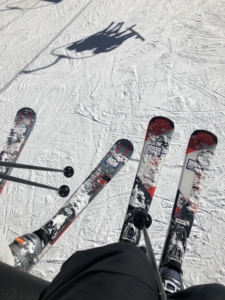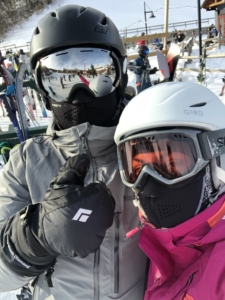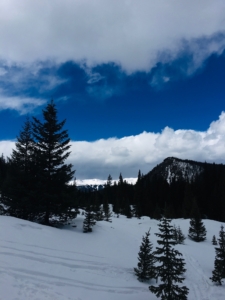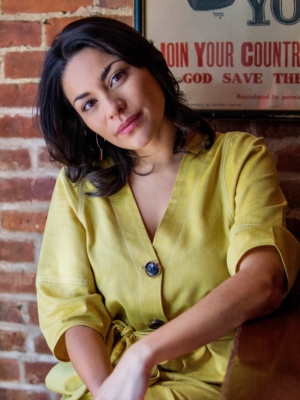This Post is Not About the Coronavirus

(It’s about skiing.) Skiing requires too many accessories. Don’t get me wrong, I like accessories. I was one of those high school kids in the early aughts with too many bracelets. But unlike Claire’s, REI (that’s Recreational Equipment, Inc., for the uninitiated) is expensive. This balaclava, for example, will run you forty-nine American dollars. Sure, it features an “easy access” detachable face mask with magnetic seams so that you can eat “without catching a chill on the hill.” It’s important to note, however, that eating on the hill is going to run you a cool Andrew Jackson for a heat lamp singed BLT and crinkle-cut French fries (the worst kind of fry, don’t @ me).
As you can probably tell, I have no problem talking about money. How much does your new job pay? How much are you renting this apartment for? These questions might make your friends uncomfortable, but knowledge is power. And I know about skiing now, so if you’re a brown girl with a white boyfriend, like me, let me be your guide. That is, unless your boyfriend is the kind of white person whose family has a boat– I can’t help you with that. Let me be your guide if your white boyfriend is from a landlocked state with a decent mountain range, because odds are he’s got a t-shirt somewhere that says “last call, first lift” and sooner or later you’re going to have to find out what that means.
Because skiing was not, let’s say, part of my culture growing up, I experienced real sticker shock when my boyfriend started planning ski trips with his friends from law school. “Excuse me,” I balked. “A lift ticket is how much? ….per day?” (It’s one hundred dollars. One. Hundred. Dollars.) I’d already bought these forty-dollar goose down mittens, and then they were telling me I needed to buy liners. Unlined mittens are obviously a scam, so for the first few ski trips you could find me in the lodge with my book and my hot toddy. In the lodge, be prepared to find a cover band going really hard on Take Me Home, Country Roads, which is a great song by a man named John Denver. You will learn that this situation is what’s referred to, in mountain culture, as “après ski”– a term for drinking and hanging out in the ski lodge. It literally means “after ski” in French. Upon explaining this, your boyfriend, seeing that look on your face, will then sweep his arm across the tableau of bodies, all swathed in ugly fleeces and raising their Coors Lights to the rafters, saying, “Just let the whiteness wash over you.”
Ski resorts are profoundly white spaces. Once, we crowded into a ski condo kitchen while our friend Chad told us that when the other resort-goers see his Puerto Rican uncle in the hallway, they ask him for towels. He owns that condo. This happens all the time, Chad told us, and when it does, his uncle just says, sure, and keeps walking. I loved this story. Can’t you just picture Chad’s Uncle? Clipping into his boots, jumping on the lift, laughing his ass off while those dummies continue waiting for their towels forever? It’s a feeling that I know, that you know, intimately, Brown Girl with a White Boyfriend– the knowledge that even if you were to get your accessories in order, even if you could glide elegantly off a black diamond and say who’s ready to hit the après?, even then, someone would eventually point to you and say something that means “You don’t belong here.”
 And yet, here I am. A bookworm, yes, but one who loves kickboxing and hiking. I have good balance and I like looking at trees. “I think you’ll love it,” my boyfriend said. So, I started taking ski lessons. Most resorts offer a learner package that includes rentals (skis, boots, poles, a helmet), a 2-hour small group lesson in the morning, and a half-day lift ticket so you can fall down the bunny hill by yourself after lunch. That’ll run you between $90-$150 dollars, depending on the mountain.
And yet, here I am. A bookworm, yes, but one who loves kickboxing and hiking. I have good balance and I like looking at trees. “I think you’ll love it,” my boyfriend said. So, I started taking ski lessons. Most resorts offer a learner package that includes rentals (skis, boots, poles, a helmet), a 2-hour small group lesson in the morning, and a half-day lift ticket so you can fall down the bunny hill by yourself after lunch. That’ll run you between $90-$150 dollars, depending on the mountain.
At the beginning of class, the instructors will sort you into beginner, intermediate, and advanced groups of about four or five. I once took a class with two fancy Upper West Side types who claimed to be skiing at the intermediate level. One of them assured the instructor that he’d been skiing about twenty times— in Colorado, Utah, and Austria. The other said she was “just” taking the class to “hone” her technique. I said that I was probably at beginner level, but when the instructor learned I had four solid days of falling under my belt, she took me with her group. When we reached the top of the mountain, both Upper West Siders promptly fell off of the lift. The just-here-to-hone-my-skills lady dipped out in the middle of the class, never to be seen again.
You can’t fake skiing. It doesn’t matter if you’ve got Aspen money or Alps money. You are either falling or you are not falling. Falling is unbecoming of an adult. It bruises the ego. And the butt. Bodies fly past you, bright blurs, and you’re afraid they’ll hit you. Your heart clenches, your adrenaline surges, your armpits somehow become sweat soaked in zero-degree weather. It’s scary.
The best advice I’ve ever gotten from a ski instructor was: “Don’t look down the mountain.” It sounds simple, and like a lot of really good advice, it is. Do not look down the mountain. Whatever your mountain may be. The mountain is too vast, too steep. You’ll only make it seem vaster and steeper by teetering at the edge, studying it, trying to plot your entire route down before you’ve even begun.
Maybe you’re feeling like you’re at the top of a mountain right now. Maybe you’re feeling scared, like you’re not sure how you’ll get through this. But don’t look down. If you look down, all the way down, at everything that you still have to do, at how very far you still have to go, at every bump, every obstacle, and at all the little tiny people who got down so much faster than you did– you will surely cry. And yell at your boyfriend for telling you that “green” meant “easy” (lies).
 I’ve overheard many couples fighting on the mountain. My friend Eve told me she overheard a man and a woman arguing on a green run once. The woman was veering out of control and her partner kept yelling “Left! Left! Make a left!” and she said, “I’ll make a left– how ’bout I make a left to Cancun?!” It’s no beach vacation, skiing. You have to wake up really early, because you want to get a good parking spot. Then you have to rush to get dressed so that you make the first lift and miss the line. Leggings, tank top, long sleeve shirt, fleece, jacket, ski pants, ski socks, boots. The boots are tight, so tight you think you’re going to sprain your ankle in the moment before they finally slip on. All this is done in a jam-packed locker room, filled with moms who are screaming for Ainsley and Maverick to put their L.L. Bean jackets on ($159.00) before they’re late for ski school.
I’ve overheard many couples fighting on the mountain. My friend Eve told me she overheard a man and a woman arguing on a green run once. The woman was veering out of control and her partner kept yelling “Left! Left! Make a left!” and she said, “I’ll make a left– how ’bout I make a left to Cancun?!” It’s no beach vacation, skiing. You have to wake up really early, because you want to get a good parking spot. Then you have to rush to get dressed so that you make the first lift and miss the line. Leggings, tank top, long sleeve shirt, fleece, jacket, ski pants, ski socks, boots. The boots are tight, so tight you think you’re going to sprain your ankle in the moment before they finally slip on. All this is done in a jam-packed locker room, filled with moms who are screaming for Ainsley and Maverick to put their L.L. Bean jackets on ($159.00) before they’re late for ski school.
But people love this. For some people, maybe, it’s a status symbol as well. A ski vacation for a family of four is not cheap. “Oh, we were just up at Mont-Tremblant for the weekend” is a tremendous flex. But for others, I know it’s more than that. Once, at New Year’s, we stayed in this cute little bed and breakfast in Vermont (flex) and got talking to the bartender. A serious, ride or die East Coaster, she made fun of us for being Westerners.
“You people are spoiled,” she scoffed, pouring two whiskeys for us and one for herself. “People come here from Colorado and Utah and they complain that it’s raining, that it’s icy. Well, so what? You still go.”
Adam raised his glass to her. “A bad day of skiing is still better than any day of not skiing.”
I studied them, these strange daredevils, and wondered when, if ever, I’d get that peaceful look on my face when I thought about spending one hundred dollars to fall on my ass. A bad day of skiing is still better than any day of not skiing— that reminded me of my grandma, once she hit her late nineties.
“How are you, grandma?”
“Well, I’m better than the alternative,” she’d chuckle.
Which I understood as: well, at least I’m not dead!
 At my next ski lesson, I moved on to the big stuff– turning. “Just take it one turn at a time,” the instructor said. This advice built beautifully on my foundational lesson (don’t look down the mountain), because now the mountain was not a mountain at all, but simply a series of turns. It reminded me of Anne Lamott’s advice on writing, that you just have to take it bird by bird. A mountain is like a school project about birds that you waited until the last minute to do. There’s only one way forward, and that’s to divide the work into manageable chunks. Set reasonable goals for yourself. Can you sit down and write an entire chapter today? Maybe not. But maybe you can write that scene you’ve been thinking out. Or maybe you can fix that dialogue that doesn’t sound right. Bird by bird. Turn by turn. Can you fly down the entire mountain without falling? Maybe not, but you can turn left, and right, and then left, and then right.
At my next ski lesson, I moved on to the big stuff– turning. “Just take it one turn at a time,” the instructor said. This advice built beautifully on my foundational lesson (don’t look down the mountain), because now the mountain was not a mountain at all, but simply a series of turns. It reminded me of Anne Lamott’s advice on writing, that you just have to take it bird by bird. A mountain is like a school project about birds that you waited until the last minute to do. There’s only one way forward, and that’s to divide the work into manageable chunks. Set reasonable goals for yourself. Can you sit down and write an entire chapter today? Maybe not. But maybe you can write that scene you’ve been thinking out. Or maybe you can fix that dialogue that doesn’t sound right. Bird by bird. Turn by turn. Can you fly down the entire mountain without falling? Maybe not, but you can turn left, and right, and then left, and then right.
Doing new things is hard– especially for adults who’ve grown unaccustomed to the process of rewiring your brain, of flexing new muscles. Going places where you aren’t comfortable, like a ski lodge where a cover band is going too hard on a song called Take It Easy which is by a band called The Eagles, and everyone is singing, because everyone knows the words but you. You didn’t know you needed liners for your mittens. Maybe, you’re afraid somebody might ask you for towels. But now you know how to take it turn by turn.
One day, you’re up there. At the top. You fill your lungs with crisp air, because, well, at least you’re not dead. Suddenly it’s quiet. Your mind quiets, too. The sun breaks through the evergreens and a vast, bright incline lies beneath you. Bodies fly past. They don’t hit you. They’re taking care not to. You get it now. It’s just you, and the ridiculous, seemingly impossible thing you’re trying to do. And somehow, for some reason, you push yourself forward. You don’t really have a choice, do you? You’re going down. The only question is, how?
Shannon C.F. Rogers is a writer of young adult novels and plays. Her work has appeared in Bodega Magazine and on stage with Tricklock Company, Lady Luck Productions, and with Vintage Theater Collective’s Sonnetfest. She earned her B.A. in Creative Writing from the University of New Mexico in 2009 and is currently pursuing her MFA in Young Adult at Antioch University Los Angeles, where she serves as an editor and blogger on Lunch Ticket. An educator with a passion for literacy, Shannon has served school communities in New York, Chicago, and her hometown of Albuquerque.





